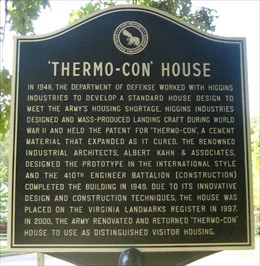History of the Thermo-Con House

1906
Thomas Edison unveils prototype housing using lightweight "foam concrete"
Thomas Edison unveils prototype housing using lightweight "foam concrete"
1923
Frank Lloyd Wright designs the first of several homes using pre-cast "textile" concrete blocks
Frank Lloyd Wright designs the first of several homes using pre-cast "textile" concrete blocks
1932
New York City's Museum of Modern Art mounts an exhibit titled "International Style," showcasing avant-garde industrial design and architectural functionalism in the U.S. and Europe
New York City's Museum of Modern Art mounts an exhibit titled "International Style," showcasing avant-garde industrial design and architectural functionalism in the U.S. and Europe
1941
United States enters World War II
United States enters World War II
1949
Thermo-Con House construction completed
Thermo-Con House construction completed
1950
Korean War begins
Korean War begins
1997
Thermo-Con House placed on Virginia Landmarks Register
Thermo-Con House placed on Virginia Landmarks Register
2000
Renovation of Thermo-Con House
Renovation of Thermo-Con House
The innovative initiatives pursued at Fort Belvoir during the post-war period were also illustrated in its residential architecture. In 1948, the well-known architectural firm of Albert Kahn & Associates designed the Thermo-Con House. This house form was intended to provide a prototype for low-cost, mass-produced housing. The construction of the house employed an innovative technique that used chemically-treated concrete that rose from its foundation like bread rising in a pan. Another major residential project during the 1970s was the McRee Barracks, a complex of mid-rise buildings constructed in 1975 to house 1,200 single enlisted men.
Read more about Fort Belvoir